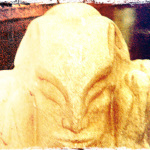Dialectic Two-Step – What Place Does Adi-Buddha Have In Pure Land Thought?
 Dialectic Two-Step is an ongoing series of my thoughts on questions that come my way.
Dialectic Two-Step is an ongoing series of my thoughts on questions that come my way.
Wisdom lies neither in fixity nor in change, but in the dialectic between the two. - Octavio Paz
What Place Does Adi-Buddha Have In Pure Land Thought?If we were to agree that Adi-Buddha represents the primordial Buddha (Samantabhadra, Vairocana, or Vajradhara) or perhaps more familiarly our Buddha nature, then we might be able to discover where it hides in the Pure Land tradition.
There are lots of layers on which to comment. The first being – all of the teachings of Buddhism share amongst them the seed of liberation. But as teachings, they are impermanent, and therefore imperfect, efforts to point out the nature of suffering and the path to cessation of suffering. The Sutra on the Buddha of Infinite Light tells us:
He dwelled in the realization that all dharmas are empty, devoid of distinctive features, and not to be sought after, and that they neither act nor arise; he thus realized that all dharmas are like magical creations.[1]
Adi-Buddha is a symbol that may speak to you well. I encourage you to follow where it takes you. However, finding a symbol’s place in a particular teaching is like trying to discover the meaning of Finnegan’s Wake by looking up each word in the dictionary. I’m not sure it will further the effort.
As to a home for Buddha nature in the Pure Land school we might look to the Sutra on the Visualization of the Buddha of Infinite Light. In the instruction we’re told that “Your mind produces the Buddha’s image, and is itself the Buddha” [1]
According to Shinran, the meditating mind implicitly refers to the entrusting mind given by the Buddha; since this mind is the Bodhi-mind and the cause of Buddhahood, it becomes a Buddha.[1] I would suggest that the Bodhi-mind, is the self-originating Buddha called Adi-Buddha.
But perhaps this is all a little too esoteric. Remembering the vow of Dharmākara (the future Amitabha), we would be wise to shift our efforts from self-power activities to reliance on other-power. For in dwelling on the impermanence of all dharmas (especially self) Bodhi-mind arises.
If, when I attain Buddhahood, sentient beings in the lands of the ten directions who sincerely and joyfully entrust themselves to me, desire to be born in my land, and think of me even ten times should not be born there, may I not attain perfect enlightenment.[1] [1] From THE THREE PURE LAND SUTRAS, part of the BDK English Tripiṭaka Series. Translated from the Chinese by Hisao Inagaki in collaboration with Harold Stewart Page on bdk.or.jp
Get Each Week's Dialectic Two Step in your email boxFirst Name:
Last Name:
Email address:
Weekly Series:
One Minute Meditations
Tiny Drops (Photography series)
Compass Songs (My Favorite Poems)
Dialectic Two-Step
Modern Koans (interesting questions)
Sunday Morning Coming Down (Music Videos)
Relics (Timeless Republished Articles)
Say What?
Quotes
The post Dialectic Two-Step – What Place Does Adi-Buddha Have In Pure Land Thought? appeared on Andrew Furst.



